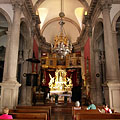(Optimerad för liten skärm enheter)
Miscellaneous photos - Tata, Ungern
Efter att ha klickat:
Klicka på bilderna!
-

The Clock Tower in the small flowered park, and the Vaszary János Primary School is behind it
Datum för fotografi: 2006-09-022006
Skapat av: Robert Németh
Kameramodell: Konica Minolta Dimage A200
Tata, Ungern
-

The baroque Capuchin Church, some distance away its wooden shingled small tower can be seen as well
The church was built between 1744-1747.
Datum för fotografi: 2006-07-152006
Skapat av: Robert Németh
Kameramodell: Konica Minolta Dimage A200
Tata, Ungern
-
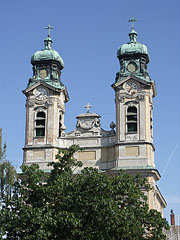
The Roman Catholic Parish Church of the Holy Cross
It was built between 1751-1784, designed by Jakab Fellner and József Grossmann.
Datum för fotografi: 2006-09-022006
Skapat av: Robert Németh
Kameramodell: Konica Minolta Dimage A200
Tata, Ungern
-
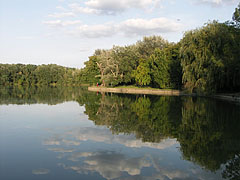
Reflections on the surface of Lake Cseke
Datum för fotografi: 2006-09-022006
Skapat av: Robert Németh
Kameramodell: Konica Minolta Dimage A200
Tata, Ungern
-

"Turkish mosque" (a building that imitates a mosque)
Built in around 1840
Datum för fotografi: 2006-09-022006
Skapat av: Robert Németh
Kameramodell: Konica Minolta Dimage A200
Tata, Ungern
-
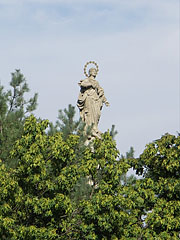
Statue of Our Lady Immaculate (Maria Immaculata) on the top of a 17-meter-tall obelisk in the main square
Created by Antal Schweiger in around 1780, restored by Ernő Szakál in 1961.
Datum för fotografi: 2006-09-022006
Skapat av: Robert Németh
Kameramodell: Konica Minolta Dimage A200
Tata, Ungern
-
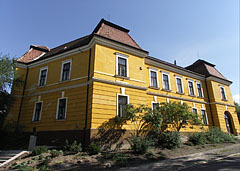
The yellow Bláthy Ottó Technical School
Formerly the school building was the Bergl's manor house and later district court. Built between 1911-1913. There is the bust statue of the Hungarian mechanical engineer and inventor Ottó Bláthy beside it.
Datum för fotografi: 2006-09-022006
Skapat av: Robert Németh
Kameramodell: Konica Minolta Dimage A200
Tata, Ungern
-
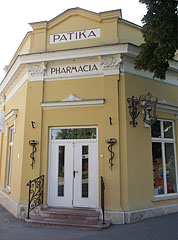
Entrance of the Tóvárosi Pharmacy ("Tóvárosi Gyógyszertár") on the corner of the yellow building
Datum för fotografi: 2006-09-022006
Skapat av: Robert Németh
Kameramodell: Konica Minolta Dimage A200
Tata, Ungern
-
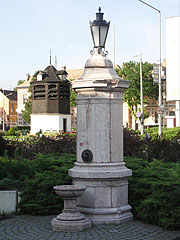
Fényes Well (literally "Shiny well"), a red limestone dringing well on the main street
Datum för fotografi: 2006-09-022006
Skapat av: Robert Németh
Kameramodell: Konica Minolta Dimage A200
Tata, Ungern
-

Motorcycle parade on the main road
Datum för fotografi: 2006-09-022006
Skapat av: Robert Németh
Kameramodell: Konica Minolta Dimage A200
Tata, Ungern
-
Motorbikes are going to the right...
Datum för fotografi: 2006-09-022006
Skapat av: Robert Németh
Kameramodell: Konica Minolta Dimage A200
Tata, Ungern
Motorbikes are going to the right... - Tata, Ungern -
...and two cyclists are going to the left, in the square in front of the Belfry (Clock tower)
Datum för fotografi: 2006-09-022006
Skapat av: Robert Németh
Kameramodell: Konica Minolta Dimage A200
Tata, Ungern
...and two cyclists are going to the left, in the square in front of the Belfry (Clock tower) - Tata, Ungern -
Clocktower or Belfry of Tata
It was constructed in 1763 by Jakab Fellner architect and József Éder master carpenter from Tata.
Datum för fotografi: 2006-09-022006
Skapat av: Robert Németh
Kameramodell: Konica Minolta Dimage A200
Tata, Ungern
Clocktower or Belfry of Tata - Tata, Ungern -
Belfry or Clock Tower of Tata, and behind it some distance away it is the Vaszary János Primary School
Datum för fotografi: 2006-09-022006
Skapat av: Robert Németh
Kameramodell: Konica Minolta Dimage A200
Tata, Ungern
Belfry or Clock Tower of Tata, and behind it some distance away it is the Vaszary János Primary School - Tata, Ungern -
Flowery park and the two-story pink builing is the János Vaszary Elementary School
It was built in 1904
Datum för fotografi: 2006-09-022006
Skapat av: Robert Németh
Kameramodell: Konica Minolta Dimage A200
Tata, Ungern
Flowery park and the two-story pink builing is the János Vaszary Elementary School - Tata, Ungern -
Motorcycle parade on the main streat
In the background on the other side of the road the "Fényes" drinking well can be seen.
Datum för fotografi: 2006-09-022006
Skapat av: Robert Németh
Kameramodell: Konica Minolta Dimage A200
Tata, Ungern
Motorcycle parade on the main streat - Tata, Ungern -
Capuchin Church
Datum för fotografi: 2006-07-152006
Skapat av: Robert Németh
Kameramodell: Konica Minolta Dimage A200
Tata, Ungern
Capuchin Church - Tata, Ungern -
Colorful mosaic on the front wall of the Capuchin Church, represents St. Francis of Assisi receiving the stigmata
Datum för fotografi: 2006-07-152006
Skapat av: Robert Németh
Kameramodell: Konica Minolta Dimage A200
Tata, Ungern
Colorful mosaic on the front wall of the Capuchin Church, represents St. Francis of Assisi receiving the stigmata - Tata, Ungern -
Fountain in front of the Small Palace
Datum för fotografi: 2006-09-022006
Skapat av: Robert Németh
Kameramodell: Konica Minolta Dimage A200
Tata, Ungern
Fountain in front of the Small Palace - Tata, Ungern -
Neoclassic late-baroque style (Copf or Zopfstil) Small Manor or "Kiskastély", the oldest building in the English Garden
Originally it was the summer residence of the Esterházy family. It was built in 1784,architect: József Grossmann.
Datum för fotografi: 2006-09-022006
Skapat av: Robert Németh
Kameramodell: Konica Minolta Dimage A200
Tata, Ungern
Neoclassic late-baroque style (Copf or Zopfstil) Small Manor or "Kiskastély", the oldest building in the English Garden - Tata, Ungern -
Lamp post in the park
Datum för fotografi: 2006-09-022006
Skapat av: Robert Németh
Kameramodell: Konica Minolta Dimage A200
Tata, Ungern
Lamp post in the park - Tata, Ungern -
Open air stage and theatre
Built in the mid-1930s
Datum för fotografi: 2006-09-022006
Skapat av: Robert Németh
Kameramodell: Konica Minolta Dimage A200
Tata, Ungern
Open air stage and theatre - Tata, Ungern -
Wide brook with a smaller waterfall
The park system with its best preserved part, namely the English Park was developed at the turn of the 18th-19th century for the Esterházy family.
Datum för fotografi: 2006-09-022006
Skapat av: Robert Németh
Kameramodell: Konica Minolta Dimage A200
Tata, Ungern
Wide brook with a smaller waterfall - Tata, Ungern -
Artificial ruins in the English Park (in Hungarian "Angolpark" or "Angolkert")
Datum för fotografi: 2006-09-022006
Skapat av: Robert Németh
Kameramodell: Konica Minolta Dimage A200
Tata, Ungern
Artificial ruins in the English Park (in Hungarian "Angolpark" or "Angolkert") - Tata, Ungern -
Romantic false ruins in the English Park or English Garden ("Angolpark" or "Angolkert")
Datum för fotografi: 2006-09-022006
Skapat av: Robert Németh
Kameramodell: Konica Minolta Dimage A200
Tata, Ungern
Romantic false ruins in the English Park or English Garden ("Angolpark" or "Angolkert") - Tata, Ungern -
The false ruins of the English Park, pointed arched gate and a relief (tombstone) from the Roman period (in the middle)
Datum för fotografi: 2006-09-022006
Skapat av: Robert Németh
Kameramodell: Konica Minolta Dimage A200
Tata, Ungern
The false ruins of the English Park, pointed arched gate and a relief (tombstone) from the Roman period (in the middle) - Tata, Ungern -
Atrificial ruins in the English Park (or English Garden)
Datum för fotografi: 2006-09-022006
Skapat av: Robert Németh
Kameramodell: Konica Minolta Dimage A200
Tata, Ungern
Atrificial ruins in the English Park (or English Garden) - Tata, Ungern -
Cseke Lake
Datum för fotografi: 2006-09-022006
Skapat av: Robert Németh
Kameramodell: Konica Minolta Dimage A200
Tata, Ungern
Cseke Lake - Tata, Ungern -
A Turkish mosque imitating building in the park
Datum för fotografi: 2006-09-022006
Skapat av: Robert Németh
Kameramodell: Konica Minolta Dimage A200
Tata, Ungern
A Turkish mosque imitating building in the park - Tata, Ungern -
Lake Cseke
Datum för fotografi: 2006-09-022006
Skapat av: Robert Németh
Kameramodell: Konica Minolta Dimage A200
Tata, Ungern
Lake Cseke - Tata, Ungern -
The main square with the Clock Tower
Datum för fotografi: 2006-07-152006
Skapat av: Robert Németh
Kameramodell: Konica Minolta Dimage A200
Tata, Ungern
The main square with the Clock Tower - Tata, Ungern -
Clock Tower in the main square
Datum för fotografi: 2006-07-152006
Skapat av: Robert Németh
Kameramodell: Konica Minolta Dimage A200
Tata, Ungern
Clock Tower in the main square - Tata, Ungern -
Motobike parade on the main street of Tata
Datum för fotografi: 2006-09-022006
Skapat av: Robert Németh
Kameramodell: Konica Minolta Dimage A200
Tata, Ungern
Motobike parade on the main street of Tata - Tata, Ungern -
Clock Tower
Datum för fotografi: 2006-09-022006
Skapat av: Robert Németh
Kameramodell: Konica Minolta Dimage A200
Tata, Ungern
Clock Tower - Tata, Ungern -
Clock Tower
Datum för fotografi: 2006-09-022006
Skapat av: Robert Németh
Kameramodell: Konica Minolta Dimage A200
Tata, Ungern
Clock Tower - Tata, Ungern -
Former manor house of the Esterházy family at the "entrance" of Tóvárosi Korzó street
This yellow building was built in the 18th century, then in the early-20th century some major changes have been made on it.
Datum för fotografi: 2006-09-022006
Skapat av: Robert Németh
Kameramodell: Konica Minolta Dimage A200
Tata, Ungern
Former manor house of the Esterházy family at the "entrance" of Tóvárosi Korzó street - Tata, Ungern -
Ancient Roman (3rd-century) tombstone with reliefs in the so-called English Park artificial ruins
The stone was found on the nearby Látó Hill.
Datum för fotografi: 2006-09-022006
Skapat av: Robert Németh
Kameramodell: Konica Minolta Dimage A200
Tata, Ungern
Ancient Roman (3rd-century) tombstone with reliefs in the so-called English Park artificial ruins - Tata, Ungern -
Boating people on Lake Cseke
Datum för fotografi: 2006-09-022006
Skapat av: Robert Németh
Kameramodell: Konica Minolta Dimage A200
Tata, Ungern
Boating people on Lake Cseke - Tata, Ungern -
Fountain near the Small Palace
Datum för fotografi: 2006-09-022006
Skapat av: Robert Németh
Kameramodell: Konica Minolta Dimage A200
Tata, Ungern
Fountain near the Small Palace - Tata, Ungern
Klicka på bilderna!
Egenskaper, karakteristika, kännetecken
Läge/plats:
GPS-koordinater: Latitud 47°39'6", Longitud 18°19'30" (N47 39.1 - E18 19.5)
Information, kort berättelser, intressanta fakta
 Clocktower or Belfry of Tata
Clocktower or Belfry of Tata
It was constructed in 1763 by Jakab Fellner architect and József Éder master carpenter from Tata.
The mid-18th-century octagonal Clock Tower or Belfry of Tata was built using a special building technique. While the red marble footing and the plastered brick wall on the lower part of the building is relatively ordinary, the wooden structure above it was built with a kind of wood assemblage technique, without using iron nails. The pyramid-shaped roof was covered with wooden shingles.
Until the World War I the Clock Tower had four bells (that's why it is called also Belfry), buth then these were removed and melted down. The renovated building was formally opened in 2004, since then there are four digitally-controlled clocks and a carillon (chime of bells) inside it. This latter could play one from the total of almost five-hundred tunes at five minutes to every hour.
The wrought-iron cross over the memorial plaque on the side that faces the main street was brought here from the nearby Capuchin Church.
 Belfry or Clock Tower of Tata, and behind it some distance away it is the Vaszary János Primary School
Belfry or Clock Tower of Tata, and behind it some distance away it is the Vaszary János Primary School
For a brief historical moment the Országgyűlés Square ("Országgyűlés tér") in Tata was in the center of the attention of Hungary. In the summer of 1510 King Vladislaus II of Hungary (aka Ladislaus Jagiellon) wanted to convene a National Assembly in Székesfehérvár, which was at that time a coronation town and the capital of Hungary. But an epidemic broke out in Székesfehérvár and the event was relocated to Tata town, more specifically it was held exactly here (the Hungarian word and the name of the square "Országgyűlés" means "National Assembly"). In the choice of the location it may have played a role that at that time the people were afraid of the epidemic and they trusted in the clear and curative water of the "crystalline springs" of Tata.
The aim of the negotiations was to discuss about joining to the League of Cambrai against the Republic of Venice. The Holy Roman Emperor, the King of France, the King of Poland, the Pope from Rome and even the delegate of Venice were among the invitees, all of them wanted to ally with the King of Hungary.
 Wide brook with a smaller waterfall
Wide brook with a smaller waterfall
The park system with its best preserved part, namely the English Park was developed at the turn of the 18th-19th century for the Esterházy family.
The so-called English Park (in Hungarian "Angolpark") in Tata town was originally developed by Ferenc Böhm engineer. The expert created the park in 1783 by taking the advantage of the favorable natural endowments (for example the springs and lakes) of the location. The English Park is nature conservation area since 1955.
 Romantic false ruins in the English Park or English Garden ("Angolpark" or "Angolkert")
Romantic false ruins in the English Park or English Garden ("Angolpark" or "Angolkert")
The artificially created romantic ruins of the "Angolpark" or "English Park" in Tata were designed by the French architect Charles Moreau, who also worked on some details of the Tata Castle. Although the "ruin" here is artificial, but it was built using the stones of a real ruin, the remains of the early-12th-century Benedictine and later Dominican abbey of Vértesszőlős. Moreover, a 3rd-century ancient Roman tombstone and relief was also built into it, which was found on the nearby Látó Hill.
Tata - Fler fotogallerier:
Du kanske också är intresserad av (Relaterade sidor):
Destinationer i reseguide:
Tata (120 bilder + 8 panorama bilder)
Komárom-Esztergom megye (county) (703 bilder + 10 panorama bilder)
Centrala Transdanubien (Közép-Dunántúl) (1 409 bilder + 20 panorama bilder)
Ungern (27 287 bilder + 163 panorama bilder)
och dessutom:
(inom här: Komárom-Esztergom megye)
Komárom (82 bilder)
Esztergom (110 bilder + 1 panorama bilder)
Tatabánya (275 bilder)
Dobogókő (116 bilder + 1 panorama bilder)
Varje panorama foto i:
Tata (8 bilder)
Komárom-Esztergom megye (county) (10 bilder)
Centrala Transdanubien (Közép-Dunántúl) (20 bilder)
Ungern (163 bilder)
Europa (165 bilder)
Alla normal bilder i:
Tata (120 bilder / 2 gallerier)
Komárom-Esztergom megye (county) (703 bilder / 13 gallerier)
Centrala Transdanubien (Közép-Dunántúl) (1 409 bilder / 31 gallerier)
Ungern (27 287 bilder / 462 gallerier)
Europa (30 494 bilder / 523 gallerier)
https://www.panadea.com/sv/guidebook/tata/photos/gal-002

Lägg till i Favoriter Lägg till Bokmärke
Dela med dina vänner!
etc.
Om oss - Ansvarsfriskrivning -
Alla rättigheter reserverade
- ©2010-2022
Neuronit Creative Studio - Mogyoród / Budapest / Ungern



